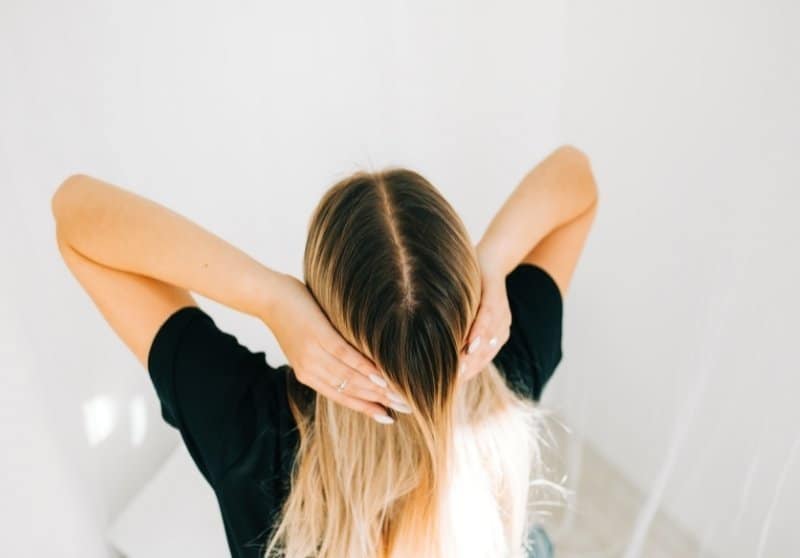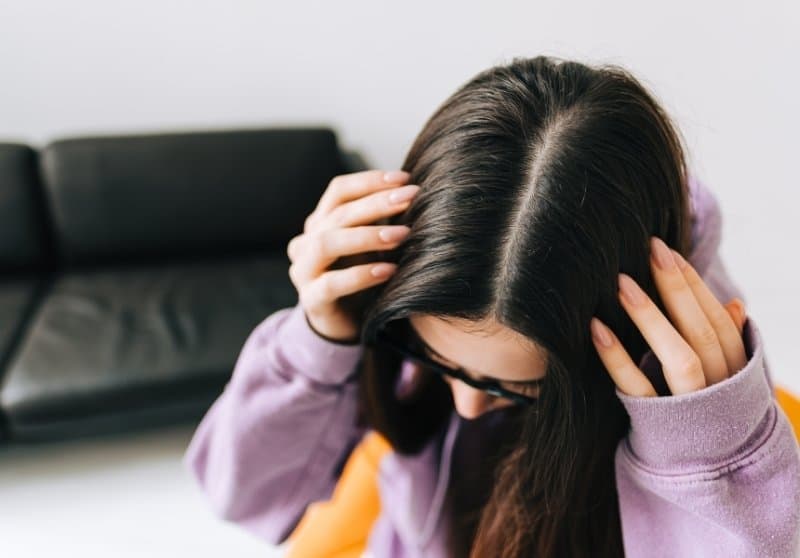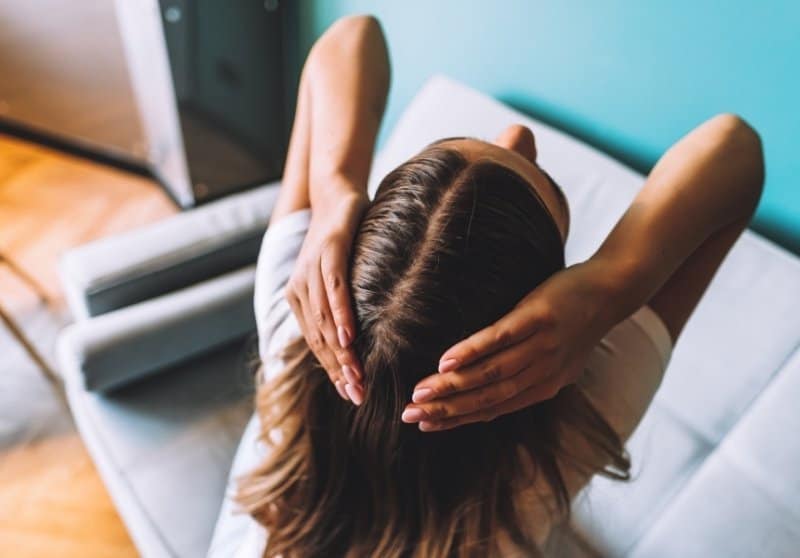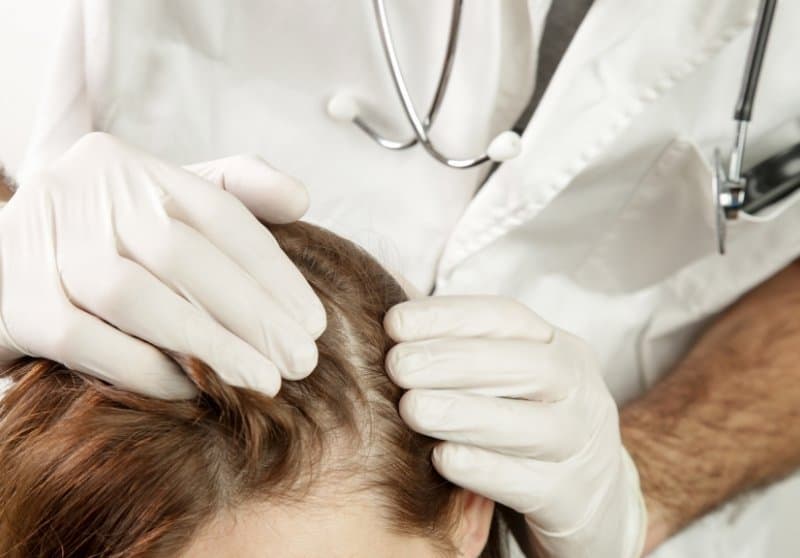Hair dye can give your locks a new identity, but how does it affect the scalp? Below we look at whether hair dye causes scalp problems.

Hair dye contains paraphenylenediamine (PPD), a chemical that can irritate and cause allergic reactions. Hair dye also contains other chemicals like ammonia and hydrogen peroxide that may cause a burning/stinging sensation, dryness, oiliness, inflammation, itching, and other scalp problems.
Typical Causes Of Scalp Problems
Scalp problems are commonly caused by:
Psoriasis
Psoriasis is an autoimmune disease and inflammatory condition that causes red patches to develop on the skin.
Common signs and symptoms of psoriasis include itching, burning, soreness, and flaky, silvery scales. Most people with psoriasis also get it on their scalp.
Scalp psoriasis may flare up if you dye your hair. That’s because some hair dyes contain chemicals that irritate the scalp.
If you already have a flare-up, it’s recommended that you treat the flare-up first before dyeing your hair to avoid increasing the risk of an adverse reaction.
You can treat scalp psoriasis with medicated shampoos that contain coal tar or salicylic acid. Alternatively, you can see your dermatologist and get a prescription.
Dandruff and seborrheic dermatitis
Dandruff and seborrheic dermatitis are two of the most common scalp problems.
The main difference between the two conditions is that seborrheic dermatitis is more severe than dandruff. Both conditions are said to be caused by the yeast Malassezia.
While it’s normal to find yeast on the scalp, an overgrowth of yeast will cause problems.
Dandruff is associated with white or gray scaling that causes itching and flaking, but it usually doesn’t cause inflammation.
You can treat mild cases with dandruff shampoo that contains selenium sulfide or zinc pyrithione.
Seborrheic dermatitis is also associated with large, greasy scaling and inflammation of the scalp.
You can treat it with antifungal shampoo or topical cortisone.
Allergic reactions
Allergic reactions can cause temporary scalp problems. For instance, most boxed hair dyes contain PPD or paraphenylenediamine, a chemical that causes contact dermatitis in people with skin sensitivity.
When dyeing your hair, the PPD is mixed with an oxidizer, and it’s more likely to cause allergic reactions when it’s in a partially oxidized state.
Avoid dyes that contain the chemical irritant you’re sensitive to minimize allergic reactions.
It’s always recommended to perform a patch test to check if hair dye exposure will negatively affect your scalp.
Tinea Capitis
Tinea capitis is a fungal infection that leads to round patches of hair loss.
The condition is also known as ringworm, and it causes hair loss because the organism affects the hair follicles.
The ring-shaped patches that appear on the scalp are raised and can be itchy and flaky.
The best way to treat tinea capitis is by taking oral antifungal medications.
Topical medicines are often ineffective because the condition extends deep into the hair follicles, where it’s difficult for topical formulations to penetrate.
Can Hair Dye Cause Oily Hair?

It’s rare for your hair to become greasy after applying hair dye.
Hair dye typically causes dryness by stripping away natural oils and damaging the cuticle layer responsible for locking moisture inside the hair shaft.
However, if you don’t rinse your hair thoroughly after dyeing, your hair could end up feeling oily. Also, your hair can become oily if the follicles in the scalp overproduce sebum. This usually happens when you wash your hair and scalp too frequently.
Your hair gets more oily because the natural oil production will increase to counteract the dryness.
How To Prevent Oily Hair When Dyeing Hair
- The best way to prevent oily hair when dyeing your hair is to avoid leaving the dye in for too long. When hair becomes too damaged, it might feel greasy and sticky.
- If you have a lot of product buildup, you also need to rinse your hair and scalp thoroughly to get rid of the greasiness.
- Avoid washing your hair more than three times a week. If you need to wash your hair more often, use dry shampoo.
- Avoid applying a super-rich conditioner or oil to your hair. If your hair has high porosity, doing this will lead to excessive oiliness.
Can Hair Dye Cause Flaky Scalp?

When you have a flaky scalp, you may notice snowy particles falling onto your shoulders.
These flakes are more visible on light-colored clothes. If you notice that your scalp is flaky after dyeing your hair, the problem could be dandruff or seborrheic dermatitis.
These conditions are not necessarily caused by hair dye, but they can be worsened after coloring your hair.
Hair dye can cause a bad reaction, which causes your scalp to shed dead skin cells at an abnormal rate, hence the flakiness. Also, if you don’t shampoo often enough or rinse the shampoo out well, the build-up or residue might dry on your scalp and start flaking off.
How To Prevent Flaky Scalp When Dyeing Hair
- Wash your hair often to prevent flakes from building up on your scalp. Try using a clarifying shampoo a week after coloring your hair. It’s formulated to deep clean your hair, but keep in mind it also fades hair color faster.
- If the flakes on your scalp are dandruff, use a dandruff shampoo. The main ingredients in dandruff shampoo that effectively get rid of flakes include selenium sulfide, zinc pyrithione, salicylic acid, or coal tar. Lather the shampoo in your hair, massage it into your scalp, and let it sit for at least five minutes before rinsing.
- Use a conditioner after washing your hair and deep condition your hair regularly to prevent flakiness.
- Make an appointment with your dermatologist if you have a severe case of dandruff or seborrheic dermatitis.
Can Hair Dye Cause Dry Scalp?
Hair dyes often include chemicals like ammonia and hydrogen peroxide that strip away the hair’s natural protective layer, causing dryness.
Ammonia has a high pH that causes hair cuticles to swell and lift, allowing the hydrogen peroxide to penetrate the cortex and break down melanin, the hair’s natural color.
Healthy hair has smooth cuticles that overlap tightly to prevent moisture loss.
After dyeing, this cuticle layer is damaged, so the chemical process causes your hair to become more porous and dry out.
Coloring your hair also removes the protective oils from your scalp, leaving it dry and vulnerable to environmental damage and other hair product chemicals.
This may lead to other scalp issues, such as inflammation or flakiness.
How To Prevent Dry Scalp When Dyeing Hair
- Make sure you have a healthy scalp before dyeing your hair. If you’re dealing with dandruff, psoriasis, or other scalp issues, it’s better to treat those issues first before coloring your hair.
- Be sure to follow product instructions and avoid using too much product or leaving it on for too long, as this might cause scalp dryness.
- Use a gentle, moisturizing shampoo and regularly condition your hair after drying to combat scalp dryness. Avoid shampoos that contain sulfates as these are harsh and have a drying effect.
- To keep your scalp healthy, you can apply moisturizing oil like argan oil or olive oil.
Can Hair Dye Cause Dandruff?

Yes, hair dye can cause dandruff by triggering a bad skin reaction. If you don’t rinse well, it can also leave a flaky residue that resembles dandruff.
The most common ingredient in hair dye that can cause allergic reactions is PPD. PPD is a chemical irritant that may cause dandruff-like symptoms.
Even if you’re not prone to dandruff, PPD can cause dryness, flakiness, and itching.
When you dye your hair, the strong chemicals strip away your natural oils, increasing the chances of developing dandruff.
If you don’t rinse the chemical mixture properly after coloring, the residue can also cause your scalp to flake the way dandruff does.
How To Prevent Dandruff When Dyeing Hair
- Use a dandruff shampoo if you notice dandruff on your scalp after coloring. If you’re prone to dandruff, it also helps to use a dandruff shampoo a few weeks before you plan to color your hair.
- Moisturizing your scalp with argan oil can help treat dryness and dandruff after coloring your hair.
- You can also mix tea tree oil with a sulfate-free shampoo. Tea tree oil has antiseptic and antimicrobial properties that help with scalp problems. However, it must be used sparingly as it can be over-drying when used excessively.
- Use a hair dye with fewer chemicals to reduce the risk of developing dandruff problems.
Can Hair Dye Cause Seborrheic Dermatitis?
Hair dye does not cause seborrheic dermatitis but can cause a flare-up in people prone to this inflammatory condition. This reaction is often caused by one particular color in hair dye, paraphenylenediamine (PPD).
PPD irritates the scalp and is associated with symptoms like stinging, itching, and inflammation.
Besides leading to contact dermatitis, coloring your hair also removes the scalp’s protective natural oils.
Overall, hair dye could leave your scalp vulnerable to damage from Malassezia, the yeast that’s linked to seborrheic dermatitis.
How To Prevent Seborrheic Dermatitis When Dyeing Hair
- Do a patch test to rule out allergies before coloring your hair.
- Avoid using box dyes that contain sensitizers like PPD if you’re allergic to this chemical irritant. PPD is included in all oxidation-type hair dyes that come with two bottles you have to mix. Instead, opt for a chemical-free, henna-based hair dye that won’t irritate your scalp.
- Apply vaseline or some other protective barrier around your scalp before dying. This prevents symptoms of contact dermatitis from developing in sensitive areas of your skin.
- Rinse your hair thoroughly to remove excess dye and follow up with a moisturizing treatment.
- If your scalp shows any signs of irritation that persist, consult a dermatologist to get a stronger prescription to treat seborrheic dermatitis.
Disclaimer: This site is not intended to provide professional or medical advice. All of the content on LovedByCurls.com is for informational purposes only. All advice should be followed at your own discretion. Ingredients may change at any time so always check the product label before using. Check our full disclaimer policy here.
